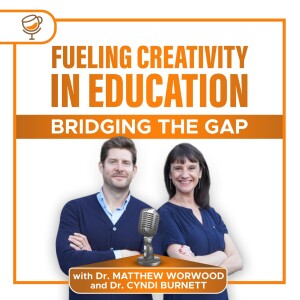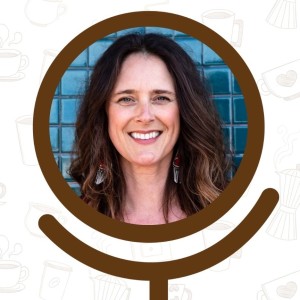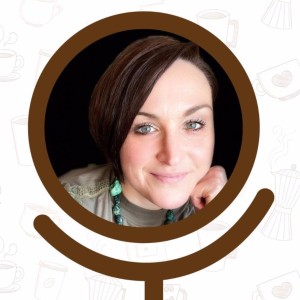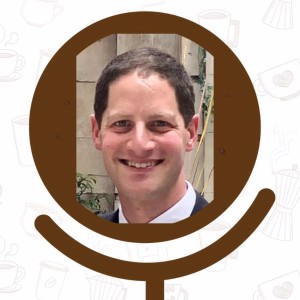Fueling Creativity in Education
The Fueling Creativity in Education podcast provides listeners with unique insights into the field of creativity research, including best practices for applying this knowledge to a traditional school environment. Thanks to deep dive interviews with renowned creativity scholars, respected practitioners, and passionate educators, every teacher and administrator will walk away with new strategies that inspire and support student and teacher creativity in and out of the classroom.
Episodes

Tuesday May 03, 2022
Bridging the Gap: Discussing Innovation v Creativity v Entrepreneurship
Tuesday May 03, 2022
Tuesday May 03, 2022
What were the biggest lessons learned during the last five episodes in Season Three of the Fueling Creativity podcast? In this final debrief, Dr. Cyndi Burnett and Dr. Matthew Worwood sit down and reflect on episodes that discussed the relationship between Innovation, Creativity, Entrepreneurship, breaking with habit-bound thinking, developing a sense of awe in students, and Inward and Outward Creativity.
Listen in as Cyndi and Matthew break down the following insights.
Major Takeaways from Season Two, Episodes 6-10:
Innovation, Creativity, and Entrepreneurship. What's the connection? Do different groups have increased value for one over the other? Or are we discussing similar things in a different context?
A sense of awe in students. Awe is a sense of considerable astonishment in a person or topic. How might teachers facilitate awe toward the curriculum or subject? Should that be an ambition for creative teachers?
Inward and Outward Creativity. Sociocultural theory informs us that the actor engages in internal and external actions that include thoughts, ideas, and reactions in response to an environment. How do internal actions interact with other people inside a classroom environment? Does a sense of connection drive these actions, and is arts a bridge between inward and outward Creativity?
Resources Mentioned:
Listen to the episode with Anna Abraham
Listen to the episode with Monica Kang
Listen to the episode with Rachelle Archer
Subscribe to our monthly newsletter!
Eager to bring more creativity into your home or classroom?
Access various creativity resources and tools & listen to more episodes of The Fueling Creativity in Education Podcast by visiting www.CreativityandEducation.com.
What to learn more about Design Thinking in Education?
Do you want to build a sustained culture of innovation and creativity at your school? Visit WorwoodClassroom.com to learn how Design Thinking can promote teacher creativity and support professional growth in the classroom.
You can also find The Fueling Creativity Podcast on Apple Podcasts, Spotify, Audible, and PodBean! Make sure to rate, review, and share the podcast if you enjoy it!

Tuesday Apr 26, 2022
Deploying Artful Leadership in Teaching and Learning with Rachelle Archer
Tuesday Apr 26, 2022
Tuesday Apr 26, 2022
What is Artful Leadership, and how might it help facilitate creativity in teaching and learning? In this episode of the Fueling Creativity podcast, Dr. Cyndi Burnett and Dr. Matthew Worwood speak with Rachelle Archer, an arts-based consultant & founder of Artful Leadership. The episode shares Rachelle's 25 + years of experience working at the intersection of arts, education, and healing, primarily with unhoused and systems-affected youth. Discussions include how artful leadership can help students reflect and connect as they interact and engage with others around them.
“Learning happens when we feel safe and when we feel connected to others in a space; it's not just something that happens inside our brains.” - Rachelle Archer
Rachelle’s Tips for Teachers and Parents:
Start with your own curiosities. Don't do anything major.
Find out what your students enjoy. Pleasure is a helpful entry point to creativity.
Avoid judgment in terms of this is good or bad, instead celebrate whatever emerges from the experience.
Resources Mentioned:
Linchpin by Seth Godin: https://www.goodreads.com/book/show/7155145-linchpin
Burnout by Emily Nagoski and Amelia Nagoski: https://amzn.to/398PEuX
Listen to the episode with Jonathan Plucker: https://bit.ly/3KZ1Ds9
Subscribe to our monthly newsletter!
Eager to bring more creativity into your home or classroom?
Access various creativity resources and tools & listen to more episodes of The Fueling Creativity in Education Podcast by visiting www.CreativityandEducation.com.
What to learn more about Design Thinking in Education?
Do you want to build a sustained culture of innovation and creativity at your school? Visit WorwoodClassroom.com to learn how Design Thinking can promote teacher creativity and support professional growth in the classroom.
You can also find The Fueling Creativity Podcast on Apple Podcasts, Spotify, Audible, and PodBean! Make sure to rate, review, and share the podcast if you enjoy it!
About Rachelle Archer
Rachelle Archer, arts-based consultant & founder of Artful Leadership, helps educators impact young lives sustainably by putting their own well-being first, so that they can lead with a full tank and create a community culture that supports students and staff. She has 25 + years of experience in youth development, working at the intersection of arts, education, and healing, primarily with unhoused and systems-affected youth. She supports organizations with healing-centered professional leadership & organizational development, helping to foster the individual, interpersonal and institutional wellness that will empower them to live into their full potential. Rachelle believes that everyone can be a leader, humans thrive in community, and the well-being of that community starts with us doing our inner work first.
Visit Rachelle’s website
Connect with her on LinkedIn

Tuesday Apr 19, 2022
Creativity and a Global Perspective of World Problems with Monica Kang
Tuesday Apr 19, 2022
Tuesday Apr 19, 2022
How does one approach creativity within a global context? How can the creative process help us and the future generations solve global problems, like climate change? In this episode of the Fueling Creativity podcast, Dr. Cyndi Burnett and Dr. Matthew Worwood speak with Monica Kang, Founder & CEO of InnovatorsBox, Author of Rethink Creativity & Have You Seen My Friends?, and Podcast Host of Dear Workplace and Curious Monica. She’s a creative educator who’s transforming today’s workforce with the mission to build a workplace for all by rethinking creativity.
Listen in to learn how she reignited her love for her job and her life through a simple mindset shift, curiosity, and creativity, as well as how that led her to help others tap into their innate creativity through InnovatorsBox. You’ll gain insight into the difference between voluntary change and forced change and how creativity and the creative process plays a role in solving complex global problems. Plus, Monica talks about the meaning behind her books, how she approaches creativity within different cultures, and how you can start incorporating curiosity, creativity, and courage into your curriculum.
“When we embed creativity as a way of living, there’s no limit to how we see and solve and approach.” – Monica Kang
Monica’s Tips for Teachers and Parents:
Before stressing about the curriculum, become aware of how you talk about creativity at home and in the classroom. We tend to embed this image of what curiosity, creativity, and courage are supposed to look like, so pay attention to where your kids think differently, identify the action of them being imaginative and creative, and encourage them to enjoy and explore that feeling courageously.
If you’re ready to build this into your curriculum, add that action part into your lessons to let them feel and experience curiosity, creativity, and courage.
Make curiosity, creativity, and courage FUN. If they’re doing it for the grade, it’s not fun. Be intentional about getting to know your kids/students and what’s fun to them.
“The whole reason why I wanted to do this was I felt creativity was inaccessible. I felt, as somebody who was in a space that was traditionally not creative, that it wasn’t for me and I know a lot of people that still feel that way.”
- Monica Kang
Resources Mentioned:
InnovatorsBox
Rethink Creativity by Monica Kang
Have You Seen My Friends? by Monica Kang
Dear Workplace Podcast
Curious Monica Podcast
Subscribe to our monthly newsletter!
Eager to bring more creativity into your home or classroom?
Access various creativity resources and tools & listen to more episodes of The Fueling Creativity in Education Podcast by visiting www.CreativityandEducation.com.
What to learn more about Design Thinking in Education?
Do you want to build a sustained culture of innovation and creativity at your school? Visit WorwoodClassroom.com to learn how Design Thinking can promote teacher creativity and support professional growth in the classroom.
Have a question? Email Dr. Burnett and Dr. Worwood at questions@fuelingcreativitypodcast.com!
You can also find The Fueling Creativity Podcast on Apple Podcasts, Spotify, Audible, and PodBean! Make sure to rate, review, and share the podcast if you enjoy it!
About Monica Kang:
Monica H. Kang is on the mission to build a workplace for all by rethinking creativity. She is the Founder & CEO of InnovatorsBox, Author of Rethink Creativity & Have You Seen My Friends, Podcast Host of Dear Workplace and Curious Monica. An internationally recognized expert in workplace creativity, she facilitates culture transformation, leadership development, and team building in a way that is fun, actionable, and relatable. Monica works with clients worldwide including Fortune 500 companies, higher education, government, and nonprofits. Prior to InnovatorsBox®, Monica was a nuclear nonproliferation policy expert. She holds an M.A. from SAIS Johns Hopkins University in Strategic Studies and International Economics and a B.A. from Boston University.
Connect with Monica Kang on LinkedIn

Tuesday Apr 12, 2022
Special Episode: Celebrating World Creativity and Innovation Week 2022
Tuesday Apr 12, 2022
Tuesday Apr 12, 2022
What are you doing for this year's World Creativity and Innovation Week? In this special episode, Dr. Cyndi Burnett and Dr. Matthew Worwood provide small tips to help celebrate creativity in your life, your classroom, and in your family.
Past Episodes Mentioned:
Listen to the episode with Wendy Ross
Listen to the episode with Natalie Nixon
Listen to the episode with Jim Friedman
Resources for World Creativity and Innovation Week
World Creativity and Innovation Day Website
Our podcast interview with the Current Chief Steward of WCIW, Dr. Jim Friedman
Creativity and Education FREE Virtual Events
Raising a Generation of Creative Thinkers
Infusing Creative Thinking into Your Higher Education Classroom
Weaving Creative Thinking into your Pre-K-High School Classroom
Day of Surprises with your Family
Check out the Creative Thinking Challenges
Create Junk Inventions
Share the Creative Thinking Skills Sheet with Your Students
Subscribe to our monthly newsletter!
Eager to bring more creativity into your home or classroom?
Access various creativity resources and tools & listen to more episodes of The Fueling Creativity in Education Podcast by visiting www.CreativityandEducation.com.
What to learn more about Design Thinking in Education?
Do you want to build a sustained culture of innovation and creativity at your school? Visit WorwoodClassroom.com to learn how Design Thinking can promote teacher creativity and support professional growth in the classroom.
You can also find The Fueling Creativity Podcast on Apple Podcasts, Spotify, Audible, and PodBean! Make sure to rate, review, and share the podcast if you enjoy it!

Tuesday Apr 05, 2022
Inclusive Maker Spaces with Caroline Haebig
Tuesday Apr 05, 2022
Tuesday Apr 05, 2022
What is a makerspace and how can makerspaces change the landscape of education? In this episode of the Fueling Creativity podcast, Dr. Cyndi Burnett and Dr. Matthew Worwood speak with Caroline Haebig, author of The Maker Playbook: A Guide to Creating Inclusive Learning Environments. Caroline sheds light on today’s makerspace movement and the benefits of high-impact, inclusive maker learning culture inside schools and school systems.
Listen in to learn how educators from different fields can use a makerspace to foster innovative design thinking and creativity, the importance of integrating design ethics into the prototype design process, and the must-have and nice-to-have materials (both raw and digital) to include in a makerspace. Then, Caroline offers expert advice on finding entry points in your curriculum for maker learning and creating a more inclusive culture in your makerspace.
“Maker learning has a lot of opportunity to help kids develop their metacognition, reflection, and self-assessment skills.” - Caroline Haebig
Caroline’s Tips for Teachers and Parents:
Maximize opportunities for kids to share curiosities and ask questions.
Provide a scaffolded design process so students know what they’re expected to know, do, and engage with during specific parts of the design process.
Get kids to think and talk about the choices and decisions they are making.
Resources Mentioned:
The Maker Playbook by Caroline Haebig
Makedo
morphi app
Disruptus
Mission Feature Feature
Tinkercad
ScratchJr
Subscribe to our monthly newsletter!
Eager to bring more creativity into your home or classroom?
Access various creativity resources and tools & listen to more episodes of The Fueling Creativity in Education Podcast by visiting www.CreativityandEducation.com.
What to learn more about Design Thinking in Education?
Do you want to build a sustained culture of innovation and creativity at your school? Visit WorwoodClassroom.com to learn how Design Thinking can promote teacher creativity and support professional growth in the classroom.
Have a question? Email Dr. Burnett and Dr. Worwood at questions@fuelingcreativitypodcast.com!
You can also find The Fueling Creativity Podcast on Apple Podcasts, Spotify, Audible, and PodBean! Make sure to rate, review, and share the podcast if you enjoy it!
About Caroline Haebig:
Based in Wisconsin, Caroline Haebig has extensive experience designing and leading professional learning for teachers, instructional coaches, and administrators nationwide. Focused on helping educators develop innovative teaching, learning, and assessment practices, she has successfully facilitated student, teacher, and administrator preparation for school system 1:1 technology initiatives to support student learning and led district -wide work in the areas of inclusive maker learning and technological literacy. Caroline Haebig is also the author of The Maker Playbook: Designing Inclusive Learning Experiences, a book for K-12 leaders and educators. An accomplished educator, Haebig was named an ISTE Emerging Leader, Apple Distinguished Educator, Google Certified Innovator, and a recipient of the Wisconsin State Superintendent Service-Learning Award, the University of Indiana Jacobs Educator Award, and the ISTE Outstanding Young Educator award.
Connect with Caroline Haebig on LinkedIn
Follow Caroline on Twitter

Tuesday Mar 29, 2022
Celebrating One Year of Fueling Creativity! Four Key Themes
Tuesday Mar 29, 2022
Tuesday Mar 29, 2022
For this very special, one-year anniversary episode of the Fueling Creativity Podcast, Dr. Cyndi Burnett and Dr. Matthew Worwood have gone through all 28 interview transcriptions from the Fueling Creativity episodes and identified four powerful themes that have emerged from these discussions. They originally presented these themes at the Creativity Expert Exchange at SUNY Buffalo State.
Today, you get to listen in on this informative and powerful presentation! Or, you can read the transcript here.
If you’d like to book Dr. Cyndi Burnett and Dr. Matthew Worwood to deliver this presentation as an interactive workshop to your school or institution, don’t hesitate to send them an email at questions@fuelingcreativitypodcast.com.
Themes & Subthemes from Year 1 of Fueling Creativity:
#1 – Setting the creative environment of the classroom
Trust and Safety
Risk-Taking- feeling comfortable making mistakes
Openness to new ideas and perspectives
Allow time for questions and exploration Encourage respectful debate
Challenging students to highest ability- not average
Value differences
Think beyond the walls of the classroom
#2 – Creative Teachers
Creative Teachers are designers
Creative Teachers Model Creative Behaviors and Attitudes
Creative Teachers are Lifelong Learners
Creative Teachers are open and willing to try new things
Creative Teachers take risks and are willing to admit if they failed or made a mistake
Creative Teachers make time for self-care
Creative Teachers don’t have all the answers
#3 – Instructional Practice
Ask Open-Ended questions
Embed time for wondering and curiosity
Expose students to diverse things (books, museums, nature, etc).
Use Inquiry/Problem Based Learning
Spend time problem-finding
Help students find meaning, purpose and connection to content
Work through ambiguity, uncertainty and complexity
Get students comfortable with discomfort and failure
Shift student perspectives, allowing an openness to new ideas
Explore feelings and emotions related to the learning/creative process
Give students agency- a choice and voice on what they are doing
#4 – The Future Creative (Preparing our students for the future!)
A person who is cable of working with people of varied backgrounds and perspectives
A person who can think ethically when selecting ideas and developing solutions
A person who can work though complex problems and manage change
A person who can identify what humans do best, and what machines might do better
A person who can work in collaboration with AI
“This pandemic, although challenging, is really highlighting the creativity that exists within the teaching profession.” - Dr. Matthew Worwood
Do you have a theme that we haven’t covered yet? Let us know! Email us at questions@fuelingcreativity.com.
Subscribe to our monthly newsletter!
Eager to bring more creativity into your home or classroom?
Access various creativity resources and tools & listen to more episodes of The Fueling Creativity in Education Podcast by visiting www.CreativityandEducation.com.
What to learn more about Design Thinking in Education?
Do you want to build a sustained culture of innovation and creativity at your school? Visit WorwoodClassroom.com to learn how Design Thinking can promote teacher creativity and support professional growth in the classroom.
You can also find The Fueling Creativity Podcast on Apple Podcasts, Spotify, Audible, and PodBean! Make sure to rate, review, and share the podcast if you enjoy it!

Tuesday Mar 22, 2022
Integrating Creative Thinking in the Classroom with Dr. Eitan Buchalter
Tuesday Mar 22, 2022
Tuesday Mar 22, 2022
What would it be like if creativity was a core pillar of your school system’s education? In this episode of the Fueling Creativity podcast, Dr. Cyndi Burnett and Dr. Matthew Worwood speak with Dr. Eitan Buchalter, Creativity Researcher and Practitioner.
Most recently, Eitan has designed and tested a school-based learning initiative that empowers students to look after and develop their creative thinking capabilities. He shares details on this unique initiative as well as his approach to developing a creativity program in school within the constraints of a curriculum or classroom environment.
Listen in to learn how Eitan is expanding creativity research to science as he highlights his research on how scientists generate ideas and produce creative outcomes. The trio also talks about creativity skills that bridge the gap between science and art, how to help your students find their interests and passions, and the importance of teaching your students to articulate their ideas.
Eitan‘s Tips for Teachers and Parents:
Incorporate intrinsic motivation and your student’s personal interests into your lessons.
Model vulnerability so your students know it’s okay to make mistakes.
Make friends with uncertainty and risk.
“I’m a big fan of uncertainty and thinking of uncertainty as an important material.”
- Dr. Eitan Buchalter
Resources Mentioned:
Listen to the episode with Wendy Ross
Listen to the episode with Sally Reis
Nurturing Creative Thinking
Subscribe to our monthly newsletter!
Eager to bring more creativity into your home or classroom?
Access various creativity resources and tools & listen to more episodes of The Fueling Creativity in Education Podcast by visiting www.CreativityandEducation.com.
What to learn more about Design Thinking in Education?
Do you want to build a sustained culture of innovation and creativity at your school? Visit WorwoodClassroom.com to learn how Design Thinking can promote teacher creativity and support professional growth in the classroom.
You can also find The Fueling Creativity Podcast on Apple Podcasts, Spotify, Audible, and PodBean! Make sure to rate, review, and share the podcast if you enjoy it!
About Dr. Eitan Buchalter:
Eitan is the Director of Innovation at the Global Governance Institute. He has two decades of experience in creativity and innovation which includes education in schools, college and university. Eitan has also brought his expertise in creative thinking to the commercial world and has worked for a wide variety of clients including: NASA, Proctor & Gamble, The Football Association and Tate Modern.
Most recently, Eitan has designed and tested a school-based learning initiative that empowers students to look after and develop their creative thinking capabilities.
Eitan has degrees from Oxford and UCL including a PhD on Ideas in Science. Most importantly though, Eitan is a father of two boys and can often be found chasing them around the beautiful Kent countryside!
Connect with Dr. Eitan Buchalter on LinkedIn

Tuesday Mar 15, 2022
Discussing Neuroscience and Creativity with Dr. Anna Abraham- Part Two
Tuesday Mar 15, 2022
Tuesday Mar 15, 2022
In this episode of the Fueling Creativity Podcast, Dr. Cyndi Burnett and Dr. Matthew Worwood speak with Dr. Anna Abraham, an E. Paul Torrance Professor in UGA’s Department of Educational Psychology and Director of the Torrance Center for Creativity and Talent Development at UGA’s Mary Frances Early College of Education.
In part two of this two-part interview, you’ll gain insight into the work of E. Paul Torrance, the father of creativity and education, along with the work that Anna is now doing within the Torrance Center for Creativity and Talent Development. She shares her vision for the department and how she intends on building upon the work of Torrance, particularly via The Torrance Festival of Ideas. As the Founding Editor of The Cambridge Elements Series in Creativity and the Imagination, Anna also sheds light on the key insights she’s learned about imagination and wonder.
“If you’ve managed to cultivate wonder in your student, you have done something magical.”
- Anna Abraham
“Being in the College of Education, our role is to be a resource, an educational resource, and part of that is getting people very instrumental together to talk about ideas that are really relevant for the community at large.” - Anna Abraham
Anna’s Tips for Teachers and Parents:
See creativity as not the domain of a few, but a skill that is basic to all of us.
Having recognized that you have this creative ability, think about what it can do for you- not as a way to make money or prove your productivity, but as a way to discover yourself and the power of your own mind.
Don’t stop being creative. Keep at it, even if it’s for a few minutes each day!
About Anna Abraham:
Anna Abraham, Ph.D. is the E. Paul Torrance Professor and the Director of the Torrance Center for Creativity and Talent Development at UGA’s Mary Frances Early College of Education. Her educational and professional training has been within the disciplines of Psychology and Neuroscience, and she has worked across a diverse range of academic institutions and departments the world over, all of which have informed her multidisciplinary focus. She investigates the psychological and neurophysiological mechanisms underlying creativity and other aspects of the human imagination. Her wide-ranging contributions to the field of creativity include theoretical, methodological and empirical advances in the context of basic and applied research. She has penned numerous publications including the sole authored book, The Neuroscience of Creativity (2018, Cambridge University Press), and the multidisciplinary edited volume, The Cambridge Handbook of the Imagination (2020). She is the Founding Editor of The Cambridge Elements Series in Creativity and the Imagination.
Visit Anna's websiteConnect with her on LinkedIn
Resources Mentioned:
Listen to part 1 linked needed
Sign up to join The Torrance Festival of Ideas
Listen to the episode with Natalie NixonListen to the episode with Jeffrey Davis
Subscribe to our monthly newsletter!
Eager to bring more creativity into your home or classroom?
Access various creativity resources and tools & listen to more episodes of The Fueling Creativity in Education Podcast by visiting www.CreativityandEducation.com.
What to learn more about Design Thinking in Education?
Do you want to build a sustained culture of innovation and creativity at your school? Visit WorwoodClassroom.com to learn how Design Thinking can promote teacher creativity and support professional growth in the classroom.
You can also find The Fueling Creativity Podcast on Apple Podcasts, Spotify, Audible, and PodBean! Make sure to rate, review, and share the podcast if you enjoy it!



